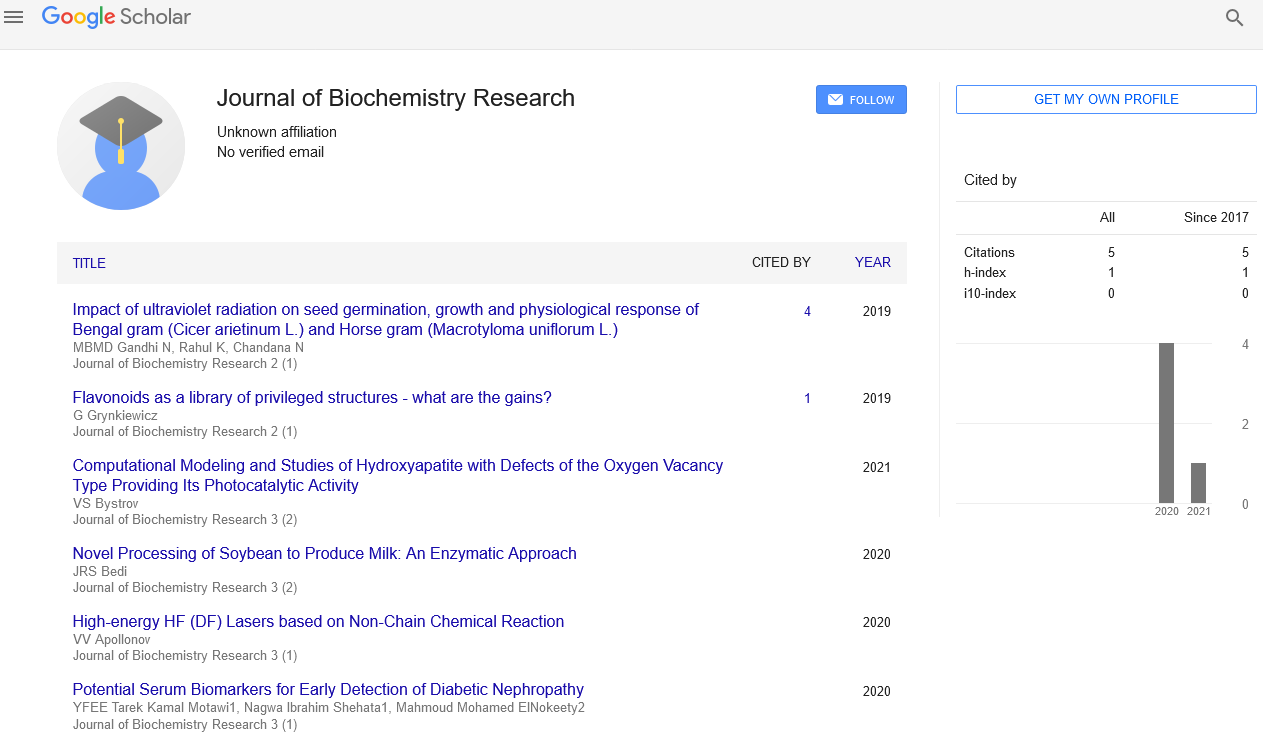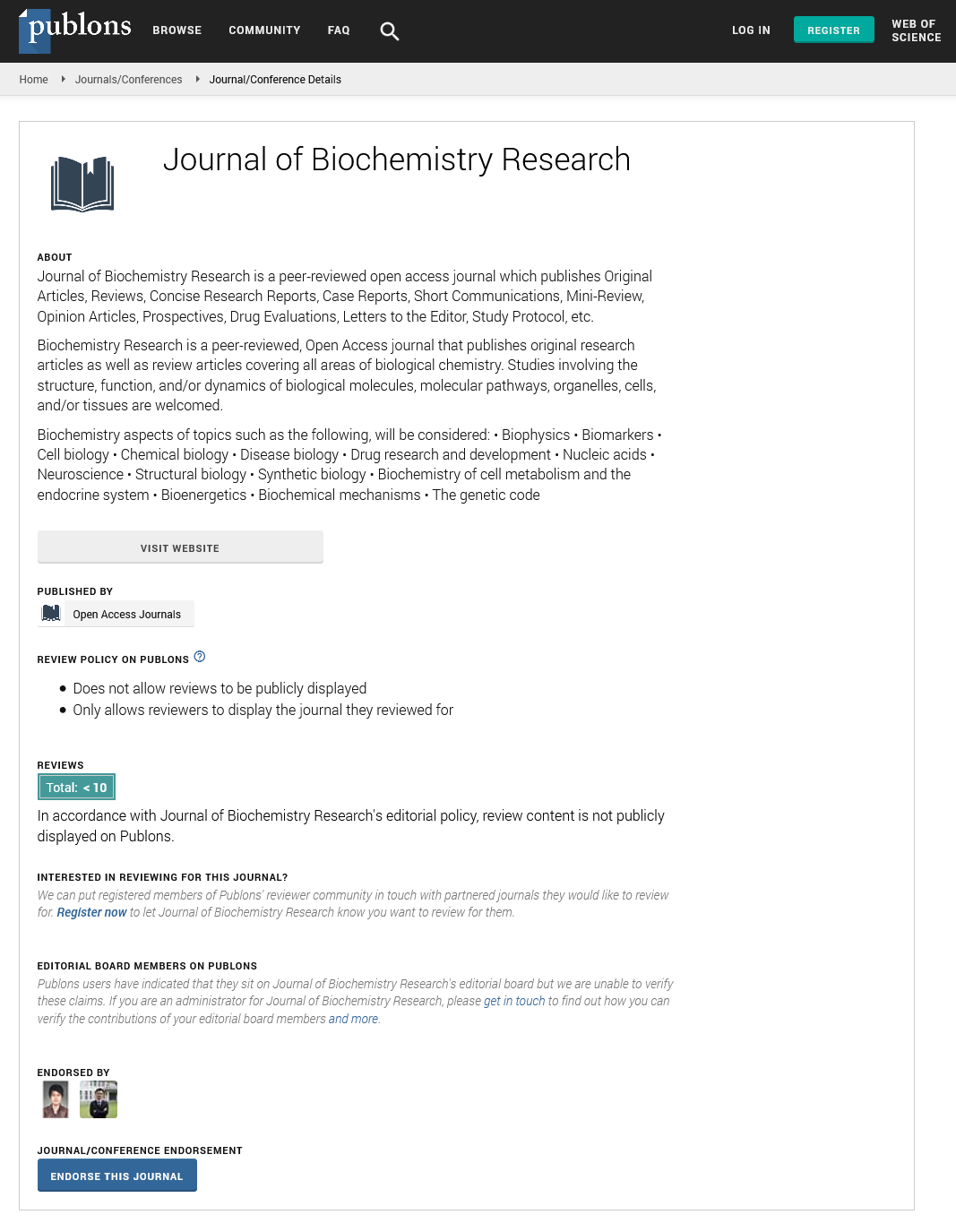Mini Review - Journal of Biochemistry Research (2023) Volume 6, Issue 2
DNA replication and gene regulation in biochemistry
Dr. Tom Rooney*
Department of gene regulation biochemistry and Gene Transformation, University of Stanford, United States
Department of gene regulation biochemistry and Gene Transformation, University of Stanford, United States
E-mail: rooneytom@gmail.com
Received: 03-April-2023, Manuscript No. oabr-23-96865; Editor assigned: 05-April-2023, PreQC No. oabr-23- 96865; Reviewed: 19-April-2023, QC No. oabr-23-96865; Revised: 21-April-2023, Manuscript No. oabr-23-96865 (R); Published: 28-April-2023; DOI: 10.37532/ oabr.2023.6(2).41-43
Abstract
DNA replication is a fundamental process in biochemistry that ensures the transmission of genetic information from one generation to the next. It is the process by which a doublestranded DNA molecule is duplicated to create two identical copies. DNA replication is a highly regulated and coordinated process that involves the action of a large number of proteins and enzymes. The process of DNA replication starts with the unwinding of the double helix, which is carried out by helicase enzymes. This creates a replication fork, which is the site where the replication process takes place. The two strands of DNA are then separated, and each strand serves as a template for the synthesis of a new complementary strand. This is accomplished by the action of DNA polymerase enzymes, which add nucleotides to the growing strand in a 5’ to 3’ direction. DNA replication is a highly accurate process, but errors can occur. These errors can result in mutations, which can have a significant impact on the functioning of an organism. To prevent such errors, there are multiple mechanisms in place to ensure the accuracy of DNA replication. These include proofreading by DNA polymerase, repair mechanisms, and checkpoint pathways that monitor the progress of replication. In addition to DNA replication, gene regulation is another crucial process in biochemistry. Gene regulation is the process by which the expression of genes is controlled. The regulation of gene expression is essential for the proper functioning of cells, tissues, and organisms. It involves a complex interplay of regulatory proteins, transcription factors, and signaling pathways
Keywords
DNA replication, biochemistry • Transmission of genetic information • Double-stranded DNA molecule • DNA polymerase • Gene regulation • Cells • Tissues and organisms
Introduction
DNA replication and gene regulation are two fundamental processes in biochemistry that are essential for the proper functioning and maintenance of all living organisms. DNA replication is the process by which DNA is copied or duplicated prior to cell division, allowing for the inheritance of genetic information from one generation to the next. This process is critical for the growth, development, and repair of cells in multicellular organisms and is tightly regulated to ensure fidelity and accuracy [1]. Gene regulation, on the other hand, refers to the mechanisms by which the expression of genes is controlled or modulated in response to various internal and external stimuli. This is a complex process that involves the interaction of various proteins, regulatory elements, and other factors to control when and how genes are expressed. Both DNA replication and gene regulation are fundamental processes that are essential for the proper functioning of living organisms. Understanding the molecular mechanisms behind these processes can provide insights into various biological phenomena and diseases, as well as contribute to the development of new therapeutic approaches [2].
The regulation of gene expression occurs at multiple levels, including transcriptional, posttranscriptional, translational, and post-translational regulation. At the transcriptional level, regulatory proteins and transcription factors bind to specific DNA sequences, either promoting or inhibiting the binding of RNA polymerase to the promoter region of a gene. Post-transcriptional regulation involves the control of mRNA stability and processing, while translational regulation controls the translation of mRNA into protein. Finally, post-translational regulation involves the modification of proteins after they are synthesized, which can affect their activity, localization, and stability [3]. The regulation of gene expression is critical for many biological processes, including development, differentiation, and response to environmental stimuli. Dysregulation of gene expression can lead to a range of diseases, including cancer, neurodegenerative disorders, and autoimmune diseases.
DNA replication and gene regulation are two fundamental processes in biochemistry that are essential for the growth and development of living organisms [4]. DNA replication is the process by which a cell copies its genetic material before cell division, while gene regulation is the process by which a cell controls the expression of its genes to produce the appropriate amount of protein at the right time.
DNA Replication
DNA replication is a complex process that involves the accurate duplication of the DNA molecule. The process is initiated by the unwinding of the double helix structure of DNA by a group of proteins known as helicases. The unwinding of the DNA molecule creates a replication fork, which is the site where the replication process occurs [5].
The next step in DNA replication is the synthesis of the new DNA strands. This is carried out by an enzyme known as DNA polymerase, which adds nucleotides to the growing DNA chain [6]. The nucleotides are added in a specific sequence determined by the complementary base pairing rule, which states that adenine (A) pairs with thymine (T), and cytosine (C) pairs with guanine (G). As a result, the newly synthesized DNA strand is an exact copy of the original DNA strand. Once the new DNA strands have been synthesized, they must be proofread and corrected for any errors that may have occurred during replication. This is carried out by a group of enzymes known as DNA repair enzymes, which recognize and correct any mistakes in the newly synthesized DNA strands [7].
Gene Regulation
Gene regulation is the process by which a cell controls the expression of its genes to produce the appropriate amount of protein at the right time. This process is essential for the proper development and function of living organisms.
There are several levels of gene regulation, including transcriptional regulation, posttranscriptional regulation, translational regulation, and post-translational regulation.
Transcriptional regulation is the process by which a cell controls the initiation and rate of transcription of a gene. This is achieved by the binding of regulatory proteins to specific regions of DNA known as regulatory elements [8]. These regulatory proteins can either enhance or inhibit the transcription of a gene. Post-transcriptional regulation is the process by which a cell controls the processing and stability of mRNA transcripts. This is achieved by a group of enzymes known as RNA processing enzymes, which modify the mRNA transcripts by removing introns, adding a 5’ cap and a poly (A) tail, and splicing exons together. The stability of the mRNA transcript is also controlled by regulatory proteins, which can either stabilize or degrade the transcript. Translational regulation is the process by which a cell controls the initiation and rate of translation of mRNA transcripts. This is achieved by regulatory proteins that bind to specific regions of the mRNA transcript known as ribosomebinding sites. These regulatory proteins can either enhance or inhibit the initiation of translation [9].
Post-translational regulation is the process by which a cell controls the modification and degradation of proteins. This is achieved by a group of enzymes known as post-translational modification enzymes, which add or remove chemical groups from proteins. The degradation of proteins is controlled by regulatory proteins, which can either target the protein for degradation or prevent its degradation [10].
Conclusion
DNA replication and gene regulation are two fundamental processes in biochemistry that are essential for the growth and development of living organisms. DNA replication ensures that the genetic material is accurately transmitted from one generation to the next, while gene regulation ensures that the appropriate amount of protein is produced at the right time. These processes are tightly regulated and coordinated to ensure the proper functioning of living organisms.
DNA replication and gene regulation are two essential processes in biochemistry that ensure the accurate transmission and expression of genetic information. Both processes involve complex networks of proteins, enzymes, and regulatory factors, and their dysregulation can have significant consequences for the functioning of cells and organisms. Understanding these processes is crucial for advancing our knowledge of biology and developing new therapies for diseases.
References
- Simó R, Hernández C. Treatment of diabetes mellitus: general goals, and clinical practice management. Revista Espanola de Cardiologia. 55,845-860 (2002).
- Makam AN, Nguyen OK. An Evidence-Based Medicine Approach to Antihyperglycemic Therapy in Diabetes Mellitus to Overcome Overtreatment. Circulation. 135, 180-195 (2017).
- Qaseem A, Vijan S, Snow V et al. Glycaemic control and type 2 diabetes mellitus: the optimal haemoglobin A1C targets, a guidance statement from the American College of Physicians. Annals of Internal Medicine. 147, 417-422 (2007).
- Beghyn T, Deprez-Poulain R, Willand N et al. Natural compounds: leads or ideas? Bioinspired molecules for drug discovery. Chem Biol Drug Des. 72: 3-15 (2008).
- Koehn FE, Carter GT. The evolving role of natural products in drug discovery. Nature Reviews Drug Discovery. 4, 206-20 (2005).
- Anderson JW, Ward K. High-carbohydrate, high-fiber diets for insulin-treated men with diabetes mellitus. Am J Clin Nutr. 32: 2312-21 (1979).
- Chandalia M, Lutjohann D, von Bergmann K et al. Beneficial effects of high dietary fiber intake in patients with type 2 diabetes mellitus. N Engl J Med. 342, 1392-8 (2000).
- Schwartz SE, Levine RA, Weinstock RS et al. Sustained pectin ingestion: effect on gastric emptying and glucose tolerance in non-insulin-dependent diabetic patients. Am J Clin Nutr. 48, 1413-7 (1988).
- Reynolds A, Mann J, Cummings J et al. Carbohydrate quality and human health: a series of systematic reviews and meta-analyses. Lancet. 393, 434-445 (2019).
- Doucet J, Chacra A, Maheux P et al. Efficacy and safety of saxagliptin in older patients with type 2 diabetes mellitus. Curr Med Res Opin. 27, 863-869 (2011).
Indexed at, Google Scholar, Crossref
Indexed at, Google Scholar, Crossref
Indexed at, Google Scholar, Crossref
Indexed at, Google Scholar, Crossref
Indexed at, Google Scholar, Crossref
Indexed at, Google Scholar, Crossref
Indexed at, Google Scholar, Crossref
Indexed at, Google Scholar, Crossref
Indexed at, Google Scholar, Crossref


